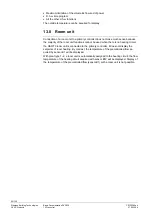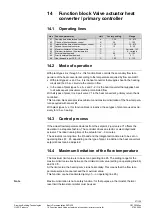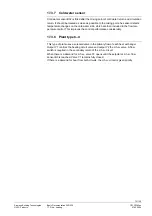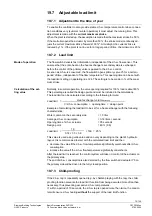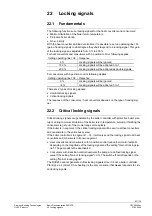
68/130
Siemens Building Technologies
Basic Documentation RVD230
CE1P2383en
HVAC Products
17 D.h.w. heating
27.05.2004
This function can be activated or deactivated on operating line 191 (function block
Miscellaneous):
0 = function deactivated
1 = function activated
17.1.5 Protection
against discharging
With the types of plant having a storage tank connected on the secondary side (coil
type or stratification storage tank, plant types x–1, x–2, x–6, x–7, x–11 and 2–12), pro-
tection against d.h.w. discharging is provided
during
pump overrun.
If the common flow temperature or the flow temperature in the intermediate circuit is
lower than the d.h.w. temperature (in the case of two storage tank sensors, the lower
actual value applies), overrun of the d.h.w. pump in the intermediate circuit will be stop-
ped prematurely. This prevents the d.h.w. from cooling down unnecessarily.
With the plant types using a diverting valve, protection against discharging acts on sys-
tem pump Q1.
On operating line 110, protection against discharging during overrun of the d.h.w. pump
can be activated (0 = no protection against discharging, 1 = protection against dis-
charging active).
With the plant types using a coil type storage tank, it is recommended to have protec-
tion against discharging always activated. This applies to plant types x–1, x–2, x–3, x–9
and 2–11.
Plant types x–6, x–7, x–10 and 2–12 with a storage tank charging pump provide protec-
tion against discharging during the charging cycle. This deactivates the storage tank
charging pump when the flow temperature falls by 2 K below the storage tank tempera-
ture. In the case of two storage tank sensors, the higher actual value applies. Depend-
ing on the type of plant, the following flow temperature will be considered:
Plant type
Flow temperature
x–6, 3–7, 2–12
B1
2–7, 6–7, x–10
B3
With the types of plant having a storage tank connected on the primary side (x–8, x–9
and x–10), protection against discharging is not required.
17.1.6 D.h.w.
heating
with diverting valve
D.h.w. heating with a diverting valve is accomplished with plant types x–11 and x–12. In
that case, the d.h.w. priority is always absolute as it is dictated by the diverting valve.
In manual operation, the diverting valve is set to the ”heating circuit” position, which
means that it will be without power.
17.1.7 Protection
against overtemperatures
If the flow temperature is too high, the heating circuit pump will overrun before d.h.w.
heating is started.
17.1.8 Storage tank with electric immersion heater
If an electric immersion heater is used in a storage tank, the setpoint adjustment is no
longer valid since in that case, the thermostat of the electric immersion heater will en-
sure temperature control of the storage tank. When, in the summer, an electric immer-
sion heater is used for d.h.w. heating, the d.h.w. setpoint must therefore be lowered to
the setpoint for frost protection. This is achieved by switching off the d.h.w. heating
mode.



